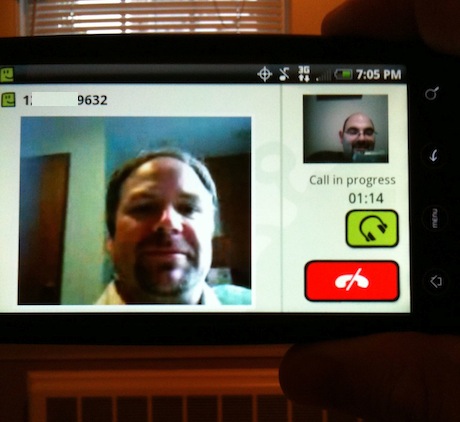Making video calls on the Sprint HTC EVO with Fring

I purchased the HTC EVO on Friday and couldn't be more impressed. I'll be sharing my impressions in the coming days, as the world gobbles up information on whatever Apple will be announcing this week. For now, though, I will say that Apple better announce some pretty amazing features with the new iPhone, otherwise Sprint's going to be running the show for a bit with its HTC EVO. The main reasons I feel this way are the EVO's ability to multitask, the insanely fast speed of its UI, HDMI out, HD video recording, HotSpot functionality, and HTC Sense, making the Android OS a pleasure to navigate.
One of the most touted features of the HTC EVO is its ability to make video calls. This is because it has a front facing camera, along with an 8 megapixel camera on its back. As for the front facing, the folks at Qik were supposed to have video conferencing software up and running, but it's still not ready as of this writing. We know it works, though, since we tried it out at the launch event last month.
Since Qik wasn't offering up a solution, I dialed up my co-author, Matt Miller, and we decided to try a video call using Fring. While it wasn't taking advantage of 4G, we did manage a couple of calls with the first one having Matt on WiFi and myself on 3G, and then both of us on WiFi. The 3G version left a lot to be desired, with delays on both ends for audio and video. However, when we were both on WiFi, there was much less lag. I'm sure this is the same issue that Qik is running into, which might be why the company is still working on an official release.
You can see a picture of the video chat between Matt and myself below.

I have also embedded a video I shot using the Qik program that comes installed on the Sprint HTC EVO. You can shoot and then instantly upload to Qik for viewing, or share it out on a variety of social networks. I'm assuming that same interface will work for live streaming, once the bugs are worked out. This video features a friend of mine sending a video to his wife, so you can imagine a real world use scenario.
I'm definitely seeing the value of video chatting from anywhere. It would also make sense that the iPhone 4G will offer the same features, though the data will end up being pretty pricey thanks to AT&T's new fees.
The funny thing about video chatting is that even though we could video chat at anytime using webcams, the concept of having our phone available and instantly sharing video is pretty wild.
While I was testing out the video chat with Matt I panned around the room a few times and he got to meet my son, his friend, and our other friends. I also saw Matt's backyard and other areas of his house. It definitely opens up the possibilities.
UPDATE: I just stumbled on a video that Matt Miller shot using his HTC EVO. Either I had my settings off or it really makes a difference to be on the 4G network--maybe a combination of both? Check out the video shot using Qik below: